So, you are invested in continuous improvement – but how do you keep yourself accountable?
“Without continuous personal development, you are now all that you will ever become.”
Those of us familiar with lean are inherently inclined to look for methods of continuous improvement, but how often do we follow a structured approach of improvement when it comes to enhancing our own personal skills and proficiency?
You could argue that the way in which we approach our own personal development is in need of some improvement.
Improving ourselves professionally requires putting time aside to identify areas of growth, setting personal goals, establishing a plan of how to achieve them, following that plan and then reviewing how the process went – all of which takes great planning and self-discipline.
So how do you keep yourself accountable when it comes to personal continuous improvement?
Introducing the world’s first online lean CPD platform
The good news is, we know how difficult all the above is without a facility in place to offer structure and accountability. That’s why we’ve created the world’s first online continuing professional development platform for the lean community.
Whilst still a self-directed process, the LCS CPD platform offers an easy-to-use and accessible online facility to structure your personal development process.
- You create your A3 plan – your roadmap to personal improvement.
- You set your own personal goals for your development cycle
- You log the activities completed in order to achieve those goals.
The LCS then simply provides feedback and comments along the way, then endorses your plan once it is complete.
We provide the tool, we help keep you accountable, but you take ownership of enhancing your personal development.
Why is it effective?
LCS CPD’s effectiveness stems from its ability to steer you down a path of self-reflection, encouraging you to think proactively about your abilities and skills in a professional environment. We trialled the LCS CPD platform with an existing member of the LCS community- a senior consultant and continuous improvement manager-to see how effective it could be. He successfully completed his 12-month plan which was subsequently endorsed by the LCS. During his review process, he provided us with some feedback:
“LCS CPD supports inward reflection and self-review. To continuously improve, we must all reflect on where things could have gone better and CPD supports that in a structured way. Learning from mistakes is how the best practitioners develop and LCS CPD provides the space in which to do this.
“I received just the right amount of support and input, without constant checking and pressure to complete tasks. The ongoing support has been superb and has allowed me to have input when I can, without the pressure to update every day.”
What else do I gain from signing up to LCS CPD?
As well as offering a vehicle for personal development and self-improvement, there are a number of additional benefits to be gained from signing up to LCS CPD. Some of these include:
- Indicating to the wider lean community that you’re staying up to date with the latest lean thinking and practice.
- Providing reassurance that your competence is being continuously improved as a result of learning and practising activities.
- Gaining a tangible achievement to display on your digital credentials profile in the form of a digital badge and CPD certificate (once your plan has been endorsed).
Want to start your road to continuous improvement? Here’s how:
Sign up to LCS CPD
LCS CPD is for lean or continuous improvement practitioners with an LCS qualification – so as long as you have an LCS Certificate, you are eligible to sign up!
At present, those registering for CPD need to be a Premium Practitioner Member. You can find out more about how to sign up to the LCS Premium Practitioner Membership, and how to enrol onto CPD, using the link below.
Tips for Optimising your Digital Credentials Profile
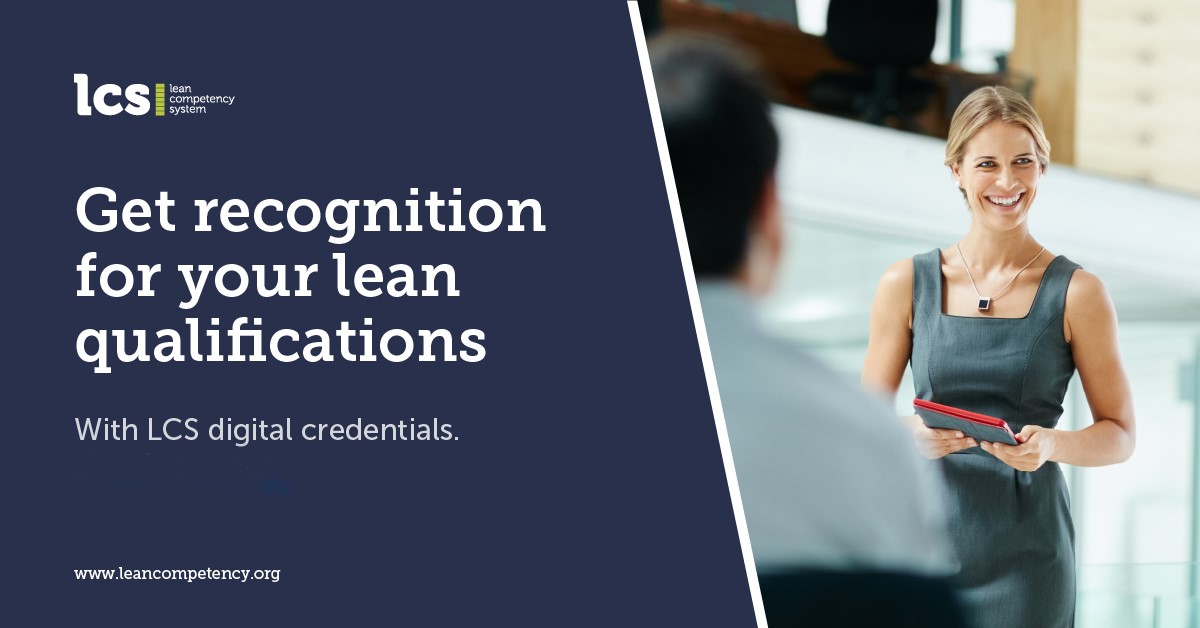
Setting up your digital credentials profile is the first step – but what happens now? How do you ensure that your profile is as strong as it can be, and how do you make sure people are seeing your profile?
First, if you haven’t yet got a digital credentials profile – our article on why digital credentials are an essential in today’s climate is a must-read.
If you’re all set up with your digital credentials profile, we have all the tips and tricks you need to make a killer professional online profile, that’s sure to deliver maximum impact.
1. Make sure your profile is filled out to the max
That means no empty fields – no-one loves a half-baked attempt. Take the extra time to fill out every aspect of your profile, and really consider what you say about yourself. This is your chance to sell yourself – include every qualification you’re proud of and write your bio in a way that authentically represents you. Remember, the idea is for it to be seen by others, so make sure it’s something you’re proud of.
2. Link your profile up with your LinkedIn account
Once your profile is ready to go, the next step is to link it up with your LinkedIn account for maximum exposure. To do this, simply:
- Go to your LinkedIn profile, and find the “Licenses & Certifications” section on your profile page.
- Click the ‘+’ sign to add licenses and certifications and the following window will come up.
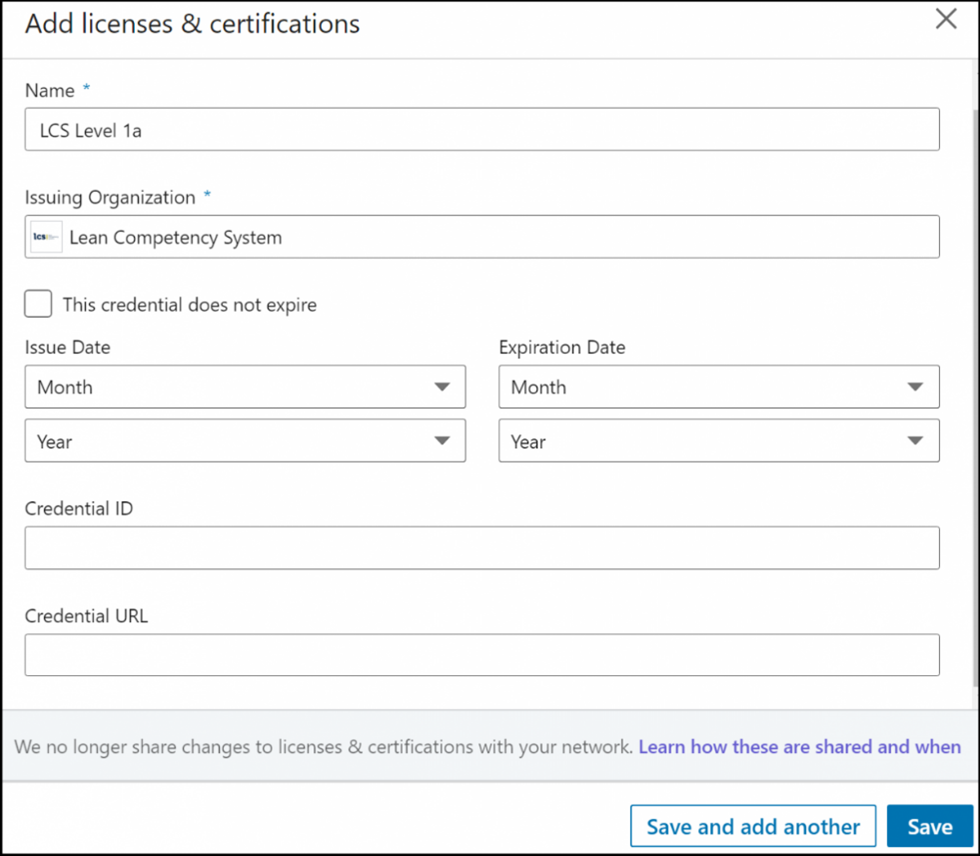
- Start filling in the fields, using the following format:
-
- Type in your LCS Level in the Name
- In the Issuing organisation field, start typing Lean Competency System – it should appear, as it is already listed as an “Issuing organisation”.
- Check the box: This credential does not expire.
- Add the issue date.
- In the Credential ID type in your LCS certificate reference.
- In the Credential URLfield, copy and paste in your LCS profile website link.
- Click Save.
Top Tip: If you have multiple LCS qualifications, add each one into LinkedIn individually so that your full lean qualification CV is displayed. You can just use your same digital credentials profile link each time.
3. Add a link to your profile in your email signature
Get a little extra exposure and give people direct access to your digital profile by adding a link to it in your email signature. This means that every time you email someone, you are potentially increasing the visibility of your professional profile. Not only does this add credibility in a professional capacity, but it also opens the door to potential career opportunities.
4. Share your profile using the social media sharing icons
Every LCS digital credentials profile has social media sharing icons, making it ultra-easy to click a button and share your profile with friends and followers. This simply offers another opportunity to expose your profile, increasing its visibility, and also allows it to be re-shared by colleagues, peers and employers.
5. Use your profile as an online CV
Whether you are job hunting or simply putting the feelers out for new career opportunities, your digital credentials profile offers a great insight into your past and present experience. Send your profile link, along with any other applications, as an accompanying tool to strengthen your resume, giving a rounded and impressive perception of your capabilities.
Have you already been promoting your digital credentials profile online? We’d love to hear how it’s helped so far! Get in touch with your feedback.
Why Digital Credentials are now more important than ever
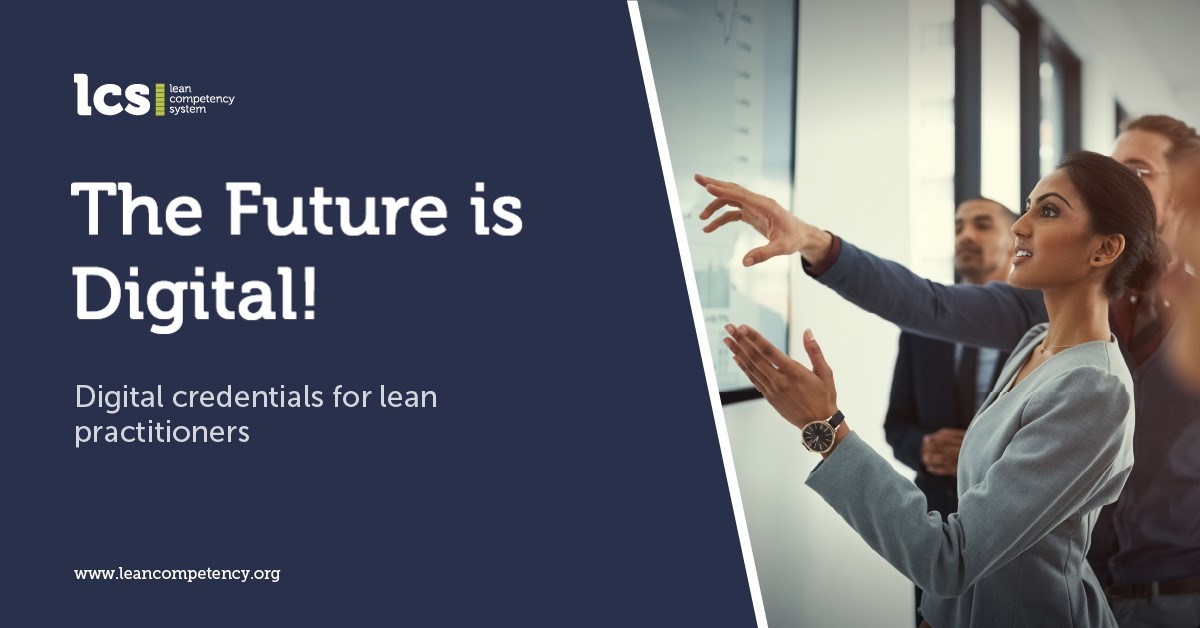
Digital credentials, upskilling and digital transformation are the professional buzzwords of 2020 – and it’s no surprise that digital is bigger than ever after the world went into lockdown.
For many businesses, digital transformation has become the ‘new normal’ and for individuals, upskilling and making sure you have a killer professional digital profile has never been more important.
At LCS, we wanted to make it easier for qualified members to showcase their verified credentials online. That’s why we recently launched a brand-new free digital credentials platform, for practitioners to create a public profile and upload their competencies and achievements to it. This can then be synchronised with your LinkedIn profile, email signatures or digital resumes.
Before we tell you how to set up your new digital credentials profile, first we’re going to tell you why having one an absolute must in today’s professional climate.
The ultimate tool for career development
Did you know that 87% of people rate professional career growth as an important factor to them in a job? This, coupled with the fact that digital credentials are here to stay, offers a solid reason for creating a strong digital profile, which is absolutely vital in today’s competitive environment.
The LCS digital credentials platform not only offers a digital space to display all your life’s achievements, but it also levels the playing field with peers who are already displaying their credentials online. Basically, it’s time to jump on the bandwagon!
Get the recognition you deserve
If you’ve worked hard to get where you are; taking the opportunity to achieve qualifications and progress your career, why not show that off and get the recognition you deserve? Gone are the days of hand delivered CV’s – we’re now lucky enough to have a digital space at our fingertips to showcase our professional achievements.
Your LCS digital credentials profile is a free tool that can synchronise with your LinkedIn profile, digital CV, email signature (and more) for all to appreciate.
Find out how to add your credentials to your LinkedIn profile here.
Bring your CV into the current digital climate
Traditional CV’s become quickly outdated, are only visible to those they’re sent to and typically only show ‘point-in-time’ achievements. What about all the other achievements you’re continuously working towards as part of your ongoing career-based learning?
Moving from only showing your CV to chosen employers, to having it out there for all to see, opens up a world of opportunity. Using an online web link for your professional profile also makes sharing details about your credentials or abilities super simple.
Show continual learning
The LCS digital credentials platform is easy to update and enables you to continuously add to your profile every time you update your skills or qualifications. This paints a real-time picture of your abilities, rather than displaying just historic achievements.
It’s the ideal way to let your employer and the community know that you are continuously striving to improve your skills and your professional profile. All it takes is small, consistent updates to your digital profile and it’s there for all to see!
Ready to set up your free digital credentials profile? Here’s how!
If you need no more convincing and are ready to set-up your profile, doing so couldn’t be easier. Here’s how…
- To set up your digital credentials profile, you must be an LCS practitioner member, with an LCS Practitioner Membership account. If you do not yet have an account, you can set one up for free here, providing you hold an LCS Certificate of Lean Competency.
- If you’re already a member, simply log in to your LCS account, select ‘My Profile’ and follow the instructions to complete your profile.
- Use this accompanying information (and the various tabs) to help you fill out your profile.
- Once it’s all filled in and you’ve hit save, you’re all set up! Now simply use this guide to help share your profile with others.
How to set up your free LCS digital credentials profile
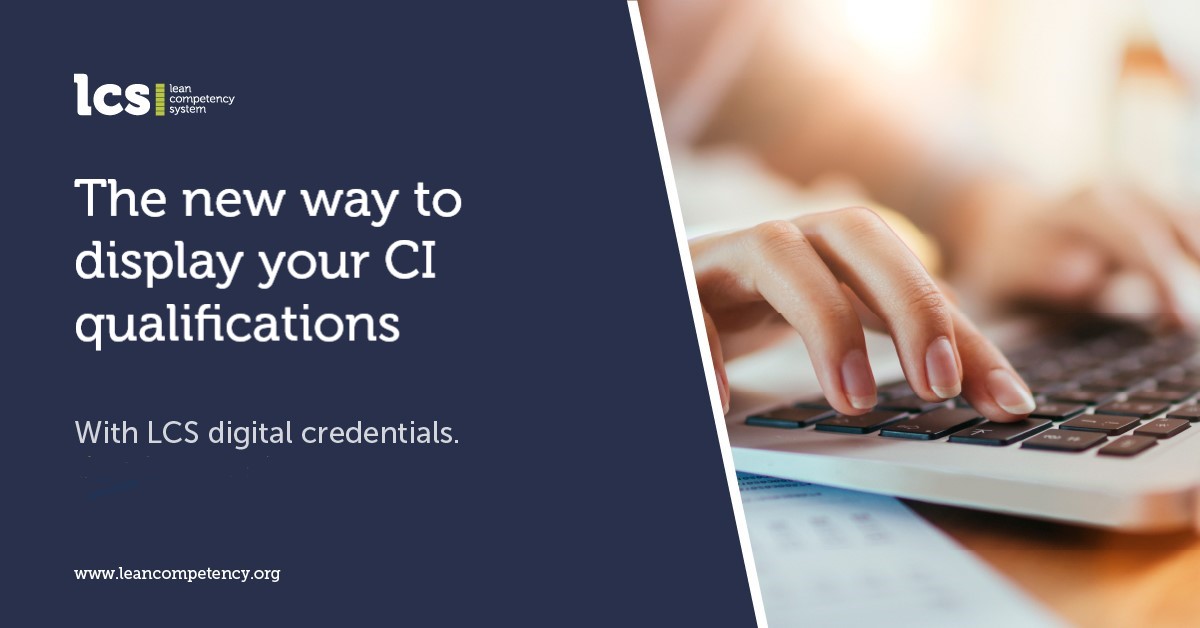
LCS has recently launched a brand-new digital credentials platform, allowing LCS practitioners to showcase their qualifications online!
As an LCS member, you are now able to join the digital credentials movement and promote your professional profile online for free, with the brand-new LCS digital credentials facility. Create your profile, showcase your verified qualifications, add links to digital certificates and then share your credentials via LinkedIn, email signatures, personal websites and more, to enhance your digital professional profile.
Here’s how to set up your free profile
Before we get started…
To set up a digital credentials profile, you must be an LCS Practitioner Member with an online LCS account. If you have an LCS qualification, but do not yet have an account, you can set one up for free by clicking here. If you have an account but forgotten your password, reset it by clicking here.
Watch the 2 minute set up guide video
Step 1: Logging in
Visit the LCS website and use the login section to log in to your account. Once logged in, click Account, then My Profile (as shown below).

Step 2: Where to edit your profile
You should now be on your empty profile. Find the Edit Profile button in the top right-hand corner and this will take you to an editable page, where you can start completing the fields.
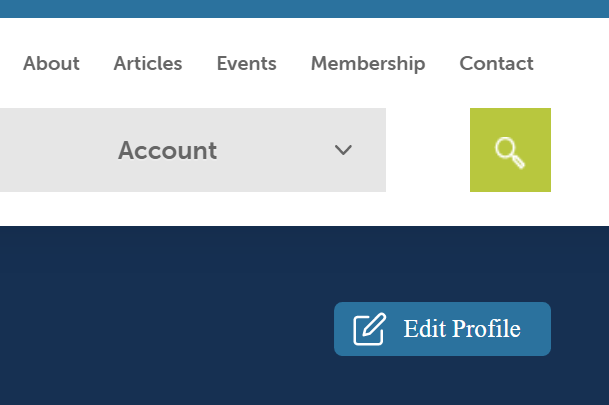
Step 3: Time to start creating your profile
Let’s start adding the information to your profile!
Top tip – Take some extra time to fill out as much of your profile as possible and write a considered biography, so that it portrays your professional abilities accurately and authentically.
Information to add:
- Personal information:
- Name, employer, position, photo, location, social media links.
- LCS qualifications.
- Other relevant CI related qualifications.
- Background information:
- General personal profile information.
- Other education.
- Previous employment.
When adding LCS or other CI related qualifications, you must upload evidence that corroborates your entry, such as the certificate that was awarded.
You can also upload complementary information that supports your other lean/CI related qualifications, such as project reports, presentations or articles.
Click Update when you have completed each section.
Step 4: We’ll review your changes and get back to you
LCS Administrators will then review and approve the LCS or CI qualifications you added. Once approved, the changes will appear on your profile.
Step 5: Let’s start promoting your digital profile online!
Now it’s all set up, it’s time to start shouting about your profile! Synchronise it with your LinkedIn profile, share it on your social media channels, add it to your email signature and professional websites and even use it to accompany your CV during job applications.
Read our article to learn more about how to maximise the impact of your digital credentials profile.
Other handy features & assets
Download LCS digital award badges for your profile
You can display a digital award badge in a range of media, including your email footer or on printed material.
Create a personal URL for your digital credentials profile
Coming soon.
The Lean-Fitness Analogy
The Lean-Fitness Analogy is a teaching aid originally developed in the Lean Enterprise Research Centre for use in lean oriented courses for practitioners and employees. It presents a comparison of going lean with getting fit and aims to communicate the ‘essence’ of lean thinking and the challenges of going lean.
Development
 Development of the Lean-Fitness Analogy started when some LERC researchers were training for a marathon and after a casual remark about the challenges of getting fit and likening it to going lean, the idea grew. The story was developed and recorded as a presentation for use in teaching.
Development of the Lean-Fitness Analogy started when some LERC researchers were training for a marathon and after a casual remark about the challenges of getting fit and likening it to going lean, the idea grew. The story was developed and recorded as a presentation for use in teaching.
Generally, it was used at the end of executive education courses, as a light hearted finale and provocative discussion aid and it proved very popular with course participants, as many could easily relate it to their own fitness attempts.
The Analogy Method
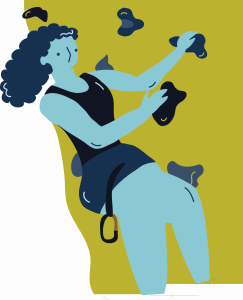 The analogy method is well established and is about the teaching of a new topic by connecting it with familiar information. It is considered an effective strategy as learners tend to find it easier to understand a topic when teachers form connections between the new topic and what is already known.
The analogy method is well established and is about the teaching of a new topic by connecting it with familiar information. It is considered an effective strategy as learners tend to find it easier to understand a topic when teachers form connections between the new topic and what is already known.
Furthermore, it is claimed that when making use of analogies that are familiar to students, retention and retrieval of information is increased, thus improving and strengthening the learning process.
There are numerous articles on the analogy method, many easily found with a web search, for example:
- Humor, Analogy, and Metaphor: H.A.M. it up in Teaching
- A Guide For Teaching With Analogies
- Teaching with analogies
- Metaphors & Analogies: Power Tools for Teaching Any Subject
Purpose
The main purpose of the Lean-Fitness Analogy is to highlight the behavioural dimension to lean thinking. It draws on an holistic, systems perspective of lean thinking, that contends that organisations must adopt a contingent approach to going lean, with a strong emphasis on individual motivation and self discipline.
The Lean-Fitness Analogy Video
The presentation has a video version, show below (7 minutes 15 seconds in length):
How to use it in teaching
The Lean-Fitness Analogy can be used in several ways in lean related courses, especially in those introducing the topic to practitioners, for example: 
- At the start of an introduction to lean, CI course:
- Have a post presentation discussion on validity, applicability and implications for going lean.
- At the end of an introduction to lean, CI course, summarising and pulling together key themes.
- In lean leadership and management courses, as it emphasises the role managers must play in motivating staff to adopt and sustain lean behaviors.
- Break out groups discussion 1:
- Groups describe the challenges of trying to get fit and relate stories and anecdotes, highlighting the measures adopted to achieve and sustain fitness, and/or reasons for failing to achieve or sustain fitness.
- The groups consider the relevance of their fitness experiences to going lean.
- Show the presentation, followed by further discussion, highlighting key take-outs.
- Break out groups discussion 1:
- Show the presentation.
- Ask groups to challenge its validity and/or extend the analogy
- Ask how would they design a lean programme in the light of the analogy.
Downloads
The following versions of the Lean-Fitness Analogy are available to download. Permitted to adapt and personalise and adapt if desired.
Please ensure that appropriate acknowledgements are always made in any version you produce – that is: author name, copyright holder (the LCS), graphics and music acknowledgement
- PowerPoint with music and automated slide transition
- Lean Fitness Analogy – no music, or automatic transitions
- Lean Fitness Analogy PDF version
Applying some Lean principles to Language Learning
The following article by Level 3 practitioner Lee Boardman talks about how to apply lean principles to different areas of learning. Lee explains how lean philosophy’s techniques can easily work as a foundation for any learning challenge we set. This includes learning something which is completely new and unfamiliar, even Persian.
With a keen interest in history, language and understanding the application of historical ideas, I embarked on a journey that would take me to some of the most exciting and unexpected locations, meet some unexpected people and forever change my view of the world.
The Catalyst
 In my early adolescent years, aside from my passion for the outdoors and many misadventures due to intense curiosity of all things, I spent a lot of time reading books and playing video games. One video game, in particular, introduced me to a historical order, named ‘the knights’ templar’. How is this snapshot relevant to Lean you ask? Well, perhaps it was the catalyst that led me down the Lean path.
In my early adolescent years, aside from my passion for the outdoors and many misadventures due to intense curiosity of all things, I spent a lot of time reading books and playing video games. One video game, in particular, introduced me to a historical order, named ‘the knights’ templar’. How is this snapshot relevant to Lean you ask? Well, perhaps it was the catalyst that led me down the Lean path.
Jumping forward to 2015, my interest had culminated in me finally making the very long and drawn out decision to select the language that I would invest my time in studying and learning. Previously failing at continuing with Japanese and French and considering hundreds of other languages I had settled on Farsi or Persian as it often better known. We often see a myriad of information and misinformation on TV news and the internet about Iran – the predominant area in which Farsi is spoken, but the reality is vastly different.
The Struggle
After sifting through the internet and collecting piles of language materials, I found myself making little progress. I had enormous amounts of data, papers, videos, books, audio classes, Podcasts etc, but I was still struggling to form any sort of coherent sentence. Why was my method not effective?
New Role
I had just started a new role at a Not-for-profit medical College and was busy implementing a Lean program. I found myself drawing correlations between how I was forming solutions for the College and how I was approaching my new endeavour of learning Persian. One night, during my long 1.5-hour train ride home, I began to formulate a hypothesis. Perhaps I could lend my Lean skills to improve my language studies.
How it started
I started by developing a value stream and defining value, I already had the Voice of the Customer, so it wasn’t difficult to quickly sketch my value stream and start identifying waste. Inventory waste saw the first cull. I had mountains of documents and data, but how much of it added value or was in active use? Transport was next to go, if I really wanted to tackle this, I needed to increase the efficiency and effectiveness in which I could access the data and from where. Now that my inventory was neat and rationalised, I uploaded it to the cloud accessible from anywhere in the world (with an internet connection) which also took care of a lot of Motion. I quickly identified defects in my personal learning style as I was a hands-on learner but up until now, I only had access to theory, so I needed to develop some tests and solutions.
A multi-cultural community
Living in a multi-cultural community, I was blessed with the opportunity to utilise the ‘What’s In It For Me’ model, where I placed an ad online for a language swap. I would teach and test conversational English for the joint benefit of being taught and tested on conversational Persian. It was a great success, I had emails coming in from all angles. My first few meetings were fairly unstructured and I could quickly see that I had not correctly broken down the goals and critical path, so after some sketching, I came up with a much better model.
A new model
I would meet at the community library, we would dedicate equal time to helping each other and developed an agreed structure of defining what we wanted to learn/achieve in between sessions. Keeping track of what was discussed and with whom using a Kanban method, allowed us to easily and efficiently navigate our new process. Waiting time was the next waste to go, I could access my data anywhere and I had multiple opportunities collaborating with other team members, so I used this opportunity to enhance the schedule. Testing the methods and measuring the data over time allowed me to improve the cycle, produce further tests scenarios and develop improvement opportunities, which was proving highly successful. With throughput significantly reduced and knowledge significantly increasing, I was ready for the real test.
The Adventure
After securing a tourist visa, I booked a trip to Iran and after a few more weeks of eagerly waiting I was finally on my way, alone to a Country that had been polarised over the years through media, which I later discovered to be very incorrect. I had never travelled alone and had never travelled this far from home, let alone to a Country that I could really only understand the very surface of from reading blogs or watching phone videos online, but I was determined.
Tehran
I landed in Tehran Airport mid-2016, to bustling conversations, ubiquitous cultural passion on display and was awed to be greeted with such courtesy, politeness and respect (airports of any country have always been a bit of a pain point for me and one of my least favourite parts of travelling). I was very relieved to find that I could understand quite a lot of the voices around me and although many people spoke too fast and with thicker accents than I was used to hearing, my current level of knowledge was allowing me to understand.
Confidence
After successfully purchasing a phone sim card and buying a bottle of water, my confidence began to grow and while I experienced a number of minor language challenges throughout my trip, applying Lean principles to my learning allowed me to quickly correct and adapt, with the added benefit of having my previous cloud solution available to access all my previous data and knowledge.
Finally
During my time in Iran, I was able to test and demonstrate the benefits of my Lean efforts and while the more detailed results are part of another story, I can conclude by stating that at the time of writing this, I have travelled to Iran 7 times in 3 years, I regularly correspond with many good friends in Iran using video chat and catch up with my Australian language friends regularly, and best of all I am sitting beside my Iranian wife who now shares my home in Australia. As for the Medical College, I am now in my third year leading the Lean program and by using the PDCA cycle, we are moving towards a bright future.

